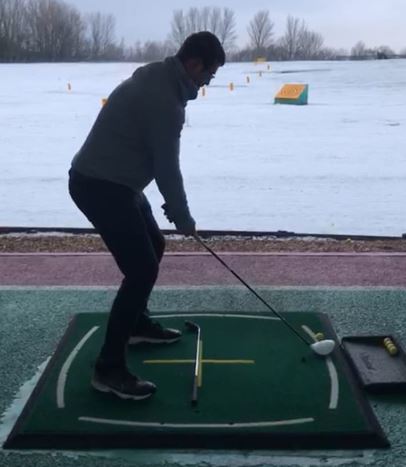How To Plumb Bob A Putt – How It Works, How Accurate Vs Aim Point

We golfers are a funny bunch aren’t we? So desperate are we to shave a few shots off, on the greens especially, we will try almost anything. We may not even need to understand it, if we see the pros do it then we’re going to explore it and give it a shot.
Back in the 60s we often saw players holding their putter up in front of their eyes before a putt. Now we watch them straddle the line of the putt and wave their fingers in front of their eyes. Put bobbing and Aim Point, respectively are our subject today, let’s dive in.
What Is Plumb Bobbing A Putt?
Firstly, until researching this article, I didn’t have a clue how this worked so we’re all learning here. This video explains it nicely. Essentially, this is a method forgetting an idea of how the ball will break on short putts, I’m talking less than ten feet here, this is no good from distance.
Stand behind the ball and hold your putter up with a light grip. Now close one eye and see how the putter is leaning. If it is leaning, and this will be slight, to one side then that is how the ball should move. The more it is leaning then the more break you need to bargain for.
Overview
Gravity causes your putts to break so why not use it to help you read the putt itself? Plumb bobbing is an old-school method of getting a feel for how the ball will move on a short putt. Think of it as a way of double-checking your read.
How To Plumb Bob A Putt

Let’s take a look at the steps you need to go through to properly employ this technique. This step-by-step guide should give you a clue but remember to just add it to your normal putting routine.
Check The Line
Go through your normal putting routine and check the line of your putt to get a feel for how the lay of the land is going to affect your ball. I like to check from behind the ball and from the behind the cup back to the ball. After this you should have an idea of what you think the ball will do.
Check Your Working
Stand a few paces behind the ball and hold your putter up toward your face, grip it in just your index, middle finger and thumb. Relax and let the putter head hang freely down toward the ground. Once it comes to rest, close one eye and observe how the putter is tilted.
Checking the Tilt
The way your are standing will cause the putt to lean slightly so if you are on sloped ground the putter will compensate. Closing one eye allows you to really observe this tilt. If your putter is leaning slightly to the left (grip has moved right, head left) then the ball should move right to left.
Let It Go
If your initial read and the tilt on the shaft match then you are good to let that putt go. This is a belts and braces approach to short putts but these ones can be make or break in your round so it’s good to pay them extra attention.
How Accurate Is Plumb Bobbing?

The Jury is kind of out on this one. I think that if it is something you use regularly and consistently then you will get good at applying it. Like everything in golf, it takes time to hone your skills so it won’t be accurate right away. You’ll soon get a feel for how much putter tilt and break relate.
What Are The Pros?
Double Check
If you are unsure of your read of even just want to be double sure, plumb bobbing can give you a bit more peace of mind. It is similar to tossing some grass in the air to check the wind. You’re already pretty sure you know what it’s doing but you want a visual check before you commit.
It Can Find Really Subtle Breaks
If you are standing over a putt and you’re convinced it is straight, this is a great way of making sure that you are correct. Sometimes we think a putt is straight but, in fact, there is a slight borrow that we’ve missed. Plumb bobbing can help us spot that and account for the borrow.
What Are The Cons?
Time
There is something to be said for feeling a putt and hitting it, almost flowing into it and not overthinking it. Adding this to your routine could just add to your prep time before a putt and knock you off your flow.
Second Guessing
Whilst it is great to double check your work before an important putt, This method could add an element of doubt into your head and that very rarely results in a good stroke. This can have you second guessing yourself at times, if you’re not careful.
Plumb Bobbing Vs Aim Point – How Do They Compare?
Aim Point has been a controversial addition to the greens in recent years. A scientific study of putting found a better way of working out break and it lead to many players around the world employing it. It starts by feeling the ground using your feet and balance to feel the break.
Like using the plumb bob to observe the effects of gravity, this system works by not solely relying on how your read a putt. Plumb bobbing is certainly a faster method but both have their merits. Aim Point continues to be used by many golfers and they absolutely swear by it!
Pros And Cons Of Aim Point
Pros
It allows you to feel your putts beneath your feet. Your body has an innate way of sensing slope so you can straddle your line and feel for how the ground lies. It is widely used on tour and elite players love what it does for their putting.
Cons
Even though they have developed Aim Point Express, this method can take quite a bit of time which is frustrating. Also, you need to be really careful not to stand on your playing partner’s line as you work out what your ball is going to do.
Plumb Bob Putting Vs Vectorputting

Vectorputting uses a special ball marker to help you work out where to start your putt. It is wonderfully elegant and makes lining up your putt more simple and consistent. Essentially you are going to line-up your putt as normal then use a line on your ball and the marker in conjunction.
The marker has a series of lines, or vectors, to help you work out aim angle. Pick a starting pint, align your ball with the marker then aim along the line of the ball. Essentially, this could be used alongside plumb bobbing as it’s a more detailed way of lining up a putt rather than feeling break.
Pros And Cons Of Vectorputting
Pros
This will undoubtedly bring more consistency into your putting as many misses come from poor alignment and not bad reading. It can also help you concentrate more on where you are starting your putt which is no bad thing.
Cons
This method could have you thinking too much about line and not enough about pace. This is a vital part of the putting process so don’t forget it. Again, this could also have you thinking about your putts a lot and not just stroking them, your feel will get you closer than you give it credit.
What Pros Plumb Bob Their Putts
This used to happen a lot back in the day. Some of the biggest names in golf through the years have employed this technique from Jack Nicklaus and Fred Couples to Nick Faldo and others. It was really popular a while back. This isn’t a technique you will see on tour any more.
What Pros Use Aim Point
Adam Scott is a famous proponent of this technique these days. Their website say they have over 200 tour wins from their system and also name guys like Max Homa, Keegan Bradley and, just recently, Justin Thomas. Even the current US Amateur champion is a user.
Conclusion

Whether you want to go old school and try plumb bobbing or try the fashionable Aim Point, the key is to feel comfortable on the greens.
Many golfers overlook the utility in a putting lesson from their pro and instead just empty techniques they see on TV or read about in magazines.
It would help a lot of golfers to really learn how to read putts and to practice putting more. It is absolutely the most important part of your game so dedicate time to it. For this reason, things like plumb bobbing and Aim Point become popular as golfers try to get an edge on the dance floor.



